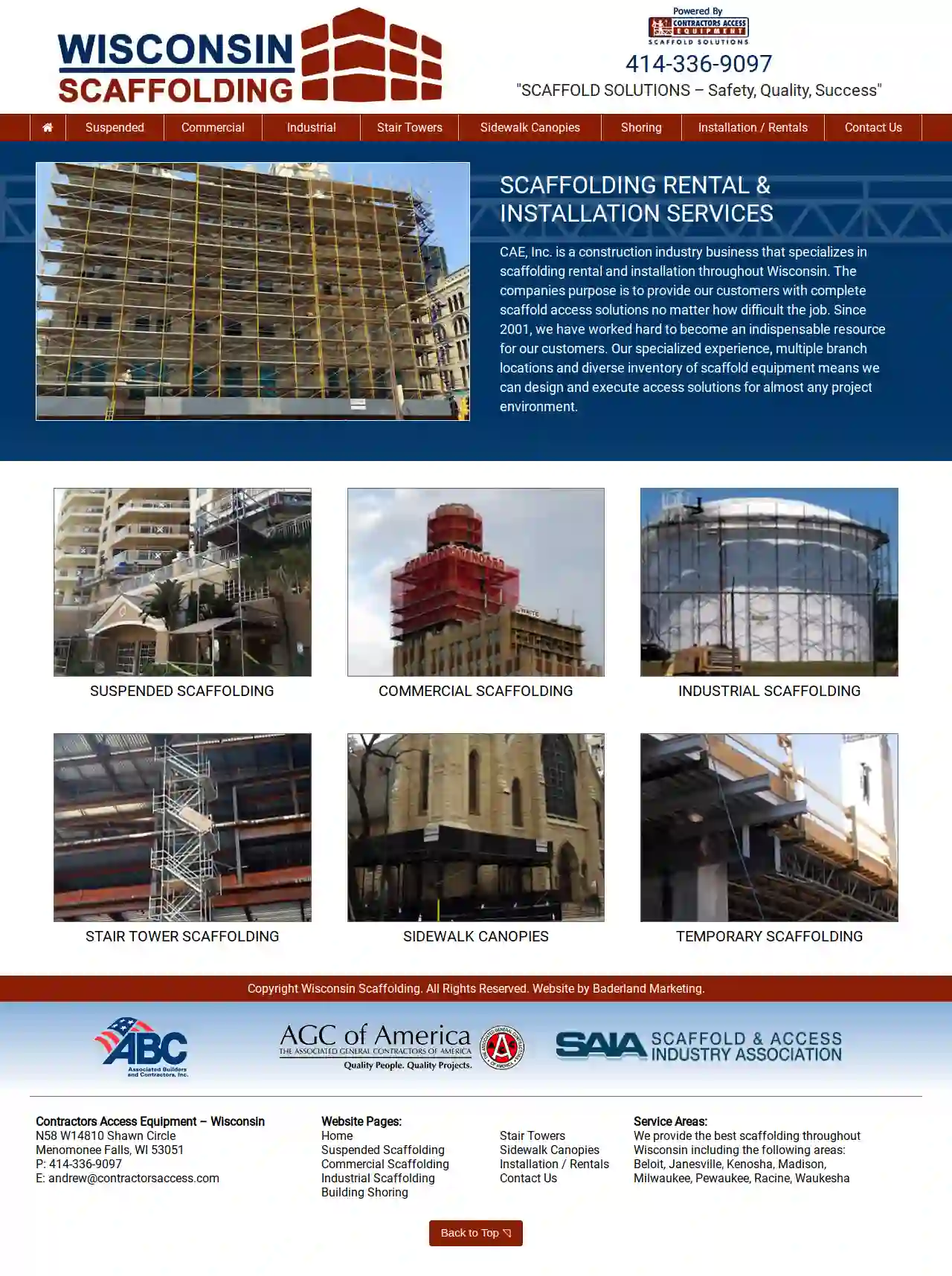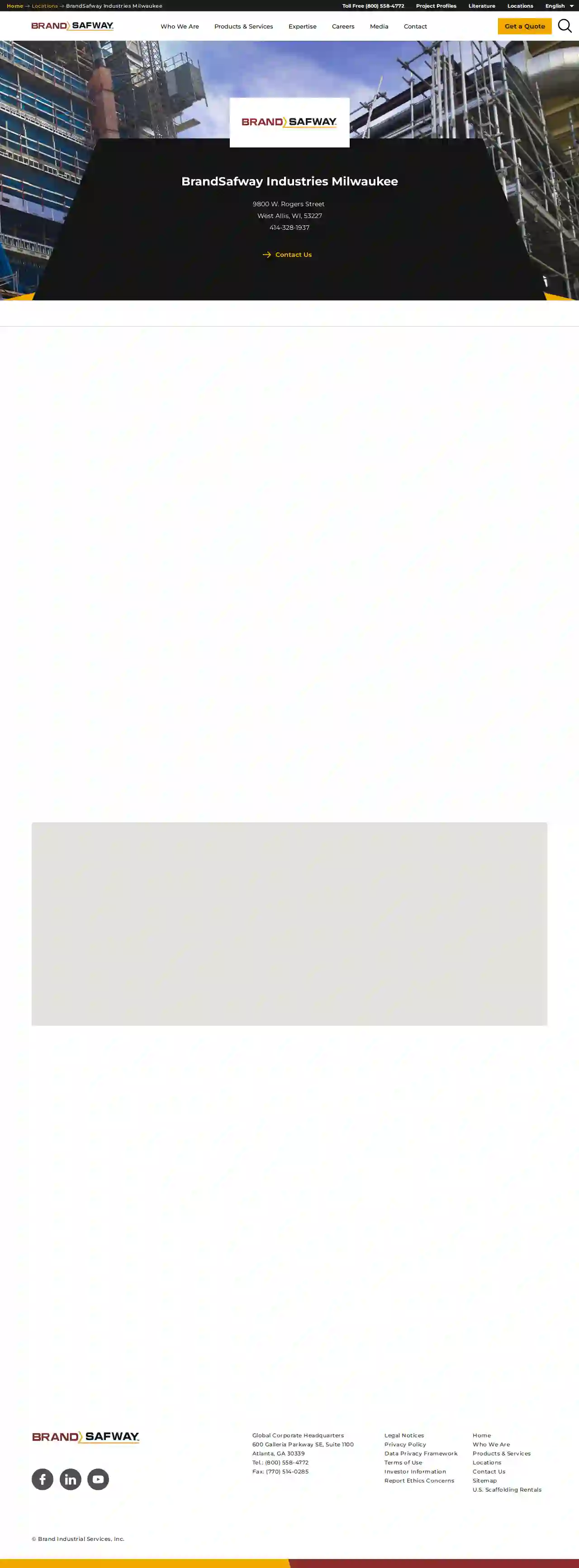Scaffolding Companies Kronenwetter
Top 10 Scaffold Services in Kronenwetter
Get 3 FREE Scaffolding Contractors quotes for your project today! Compare profiles, reviews, accreditations, portfolio, etc... and choose the best deal.

API Construction
51 reviews2725 S 163rd Street, New Berlin, 53151, USAPi Construction is a trusted scaffold and high-reach equipment expert in Milwaukee, Wisconsin. We provide safe, reliable, and high-quality access equipment, scaffold, accessories, and safety training for contractors. Our commitment to safety is the essence of how we perform our best and safest projects. We believe that zero injuries are achievable and the expectation of our company. We offer a variety of scaffold rental and expert design solutions, including custom-engineered scaffold solutions with erection and dismantle services. Our team of skilled scaffold engineers and designers provides total end-to-end support of your scaffold requirements, no matter the project scope. We are proud to be powered by the APi Group and are ready to serve your projects in Wisconsin and the surrounding area.
- Services
- Why Us?
- Accreditations
- Our Team
- Gallery
Get Quote
Badger Ladder LLC
4.637 reviewsMilwaukee, USBadger Ladder is a trusted supplier of scaffolding for sale, ladders, and pump jacks, with nearly 30 years of industry experience. Our scaffolding products offer customizable heights for easier access to difficult areas, and are built to last. We provide various types of scaffolding, including cross braces, stacking pins, and scaffold planks to meet all your project needs. Our scaffolding for sale online offers the advantages of powder-coat paint, preventing rust, and a cope-welded design for enhanced strength. Designed to meet the demands of any workload, our scaffolding is suitable for both interior and exterior use.
- Services
- Why Us?
- Gallery
Get Quote
Wisconsin Scaffolding
Menomonee Falls, WI, N58 W14810 Shawn Circle, 53051, USContractors Access Equipment, Inc. (CAE) is a construction industry business specializing in scaffolding rental and installation throughout Wisconsin. Since 2001, CAE has worked hard to become an indispensable resource for customers. With specialized experience, multiple branch locations, and a diverse inventory of scaffold equipment, CAE can design and execute access solutions for almost any project environment. CAE provides the best scaffolding throughout Wisconsin, including Beloit, Janesville, Kenosha, Madison, Milwaukee, Pewaukee, Racine, and Waukesha.
- Services
- Why Us?
- Accreditations
- Our Team
- Testimonials
- Gallery
Get Quote
BrandSafway Industries Milwaukee
410 reviews1234 Industrial Drive, Milwaukee, 53203, USBrandSafway is a leading provider of access solutions, including scaffolding, aerial work platforms, and forming and shoring. With a strong commitment to safety, quality, and customer satisfaction, BrandSafway offers a wide range of services tailored to meet the unique needs of clients across various industries. Their team of experienced professionals works closely with clients to understand their requirements and deliver customized solutions that enhance efficiency and productivity. BrandSafway is dedicated to providing innovative access solutions that ensure safe and efficient project execution.
- Services
- Why Us?
- Accreditations
- Our Team
- Testimonials
Get Quote- Br
BrandSafway Industries Wisconsin Rapids
44 reviewsMilwaukee, US- Services
- Why Us?
Get Quote
Over 2,353+ Scaffolding Contractors in our network
Our scaffolding experts operate in Kronenwetter & surroundings!
ScaffoldingHQ has curated and vetted the Best Scaffolding Contractors near Kronenwetter. Find a trustworthy pro today.
Frequently Asked Questions About Scaffolding Companies
- Work at Height Regulations 2005: Covers all work at height and outlines the need for risk assessments, competent erectors, and safe equipment.
- Construction (Design and Management) Regulations 2015 (CDM): Applies to construction projects and requires planning for scaffolding safety throughout the project lifecycle.
- British Standard BS EN 12811: Sets standards for the design, manufacture, and testing of scaffolding components.
- NASC (National Access & Scaffolding Confederation) Guidance: Provides industry best practices and safety recommendations for scaffolding.
- Regulations: Local regulations often specify minimum inspection intervals.
- Project Type and Duration: Long-term projects or those in challenging environments may require more frequent inspections.
- Weather Conditions: Severe weather (storms, high winds) can necessitate additional inspections.
- Any Alterations or Modifications: Any changes to the scaffolding structure require re-inspection.
- Traditional and highly versatile.
- Components (tubes, clamps, boards) are assembled on-site.
- Adaptable to complex shapes and structures.
- Requires skilled labor and more time for erection.
- Pre-engineered, modular components.
- Faster and easier to erect.
- Often has higher load capacities.
- May be less versatile for complex shapes.
- Online Directories: Use specialized directories like ScaffoldingHQ to search for scaffolding companies in your area.
- Search Engines: Use Google or other search engines to search for 'scaffolding companies near me' or 'scaffolding rental [your location]'.
- Local Construction Associations: Contact local construction associations for recommendations.
- Word-of-Mouth Referrals: Ask friends, family, or colleagues for recommendations based on their past experiences.
What are the safety regulations for scaffolding in the USA?
How often should scaffolding be inspected?
What is the difference between tube and clamp scaffolding and system scaffolding?
Tube and Clamp Scaffolding:
How can I find scaffolding companies near me?
What are the safety regulations for scaffolding in the USA?
- Work at Height Regulations 2005: Covers all work at height and outlines the need for risk assessments, competent erectors, and safe equipment.
- Construction (Design and Management) Regulations 2015 (CDM): Applies to construction projects and requires planning for scaffolding safety throughout the project lifecycle.
- British Standard BS EN 12811: Sets standards for the design, manufacture, and testing of scaffolding components.
- NASC (National Access & Scaffolding Confederation) Guidance: Provides industry best practices and safety recommendations for scaffolding.
How often should scaffolding be inspected?
- Regulations: Local regulations often specify minimum inspection intervals.
- Project Type and Duration: Long-term projects or those in challenging environments may require more frequent inspections.
- Weather Conditions: Severe weather (storms, high winds) can necessitate additional inspections.
- Any Alterations or Modifications: Any changes to the scaffolding structure require re-inspection.
What is the difference between tube and clamp scaffolding and system scaffolding?
Tube and Clamp Scaffolding:
- Traditional and highly versatile.
- Components (tubes, clamps, boards) are assembled on-site.
- Adaptable to complex shapes and structures.
- Requires skilled labor and more time for erection.
- Pre-engineered, modular components.
- Faster and easier to erect.
- Often has higher load capacities.
- May be less versatile for complex shapes.
How can I find scaffolding companies near me?
- Online Directories: Use specialized directories like ScaffoldingHQ to search for scaffolding companies in your area.
- Search Engines: Use Google or other search engines to search for 'scaffolding companies near me' or 'scaffolding rental [your location]'.
- Local Construction Associations: Contact local construction associations for recommendations.
- Word-of-Mouth Referrals: Ask friends, family, or colleagues for recommendations based on their past experiences.